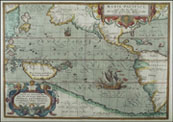|
Antique Maps of the Pacific Ocean
The western discovery of the Pacific Ocean in the early 1500s marked the beginning of a period of exploration that was not completed, amazingly enough, until the current century, with the exploration of the interior of Papua New Guinea. This page displays and discusses some early maps of the Pacific Ocean.
 |
Abraham Ortelius, 1589
The first map of the Pacific Ocean, as well as the first map naming North and South America. New Guinea is exaggerated, but everything south of it is unknown and masked by a cartouche. The National Library of Australia has an on-line, digitized copy of this map, which allows you to zoom in to see the finest details. |
 |
Jan Jannson, 1650
After sixty years of exploration, starting to see more accurate representations of parts of the Pacific, but at the same time some interesting errors. Note how Baja California has turned into an island. A long string of islands fills the south Pacific, while a large land mass is in the north.
|
 |
Pieter Goos, 1666
An unusual map of the Pacific with north oriented to the right. The major land masses are found on the edges of the map, with California at thebottom and Japan at the top. |
 |
Johannis Van Keulen, 1684
A detailed sea chart of the Pacific, focusing on the southern Pacific. Although its hard to see in this image, there are lots of place names along the coasts of North and South America. Unlike the Jansson map above and the Coronelli map below, Van Keulen doesn't show a string of islands in the south, but instead has used that area for his cartouche. |
 |
Vincenti Coronelli, 1691
Despite another forty years of exploration, not a lot has changed. The northern end of the island of California has changed shape, and the islands in the south Pacific have magically merged to form the coastline of a non-existent continent. A few new spots in Australia and New Zealand have been mapped. |
 |
Jacques Bellin, 1753
This map focuses more on the southern Pacific Ocean than the preceding maps. He presents a still incorrect view of Australia, with New Guinea and Tasmania connected to the mainland, and an imaginary east coast. The mysterious southern continent has disappeared. The coast of South America is now quite accurate. |
 |
Dépôt des Cartes et Plans de la Marine, 1776
A French map drawn several years after Cook's explorations of Australia, this map still shows nothing of its east coast, but at least removed the erroneous coastline showed in the Bellin map above. |
 |
Heinrich Scherer, 1703
This is a very unusual map of the Pacific - a mirror image of the Pacific with east (with the island of California) on the left and west (with Japan obvious) on the right. The large globe, showing the Indian Ocean, is also reversed. Click on the map for larger image. |
|
